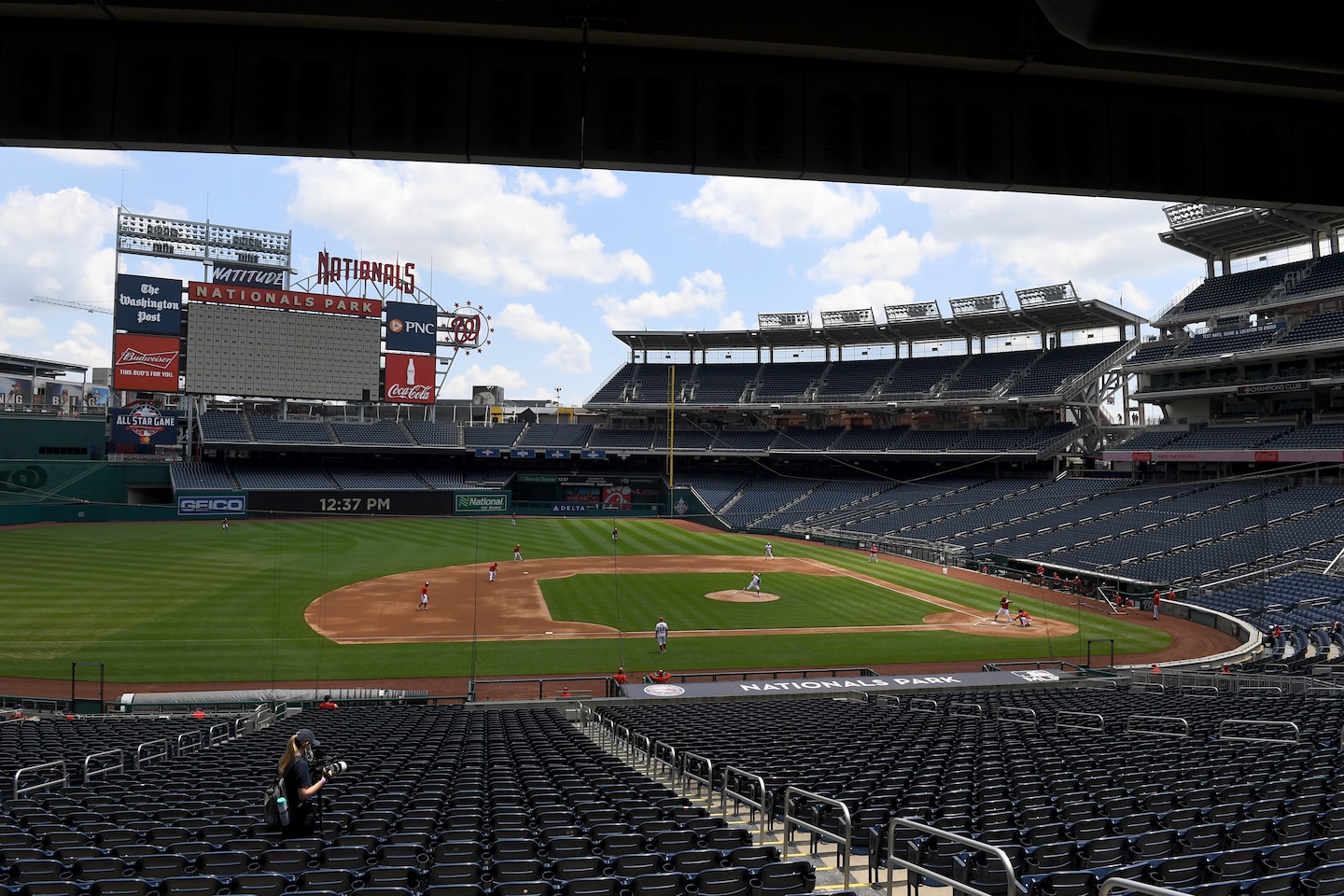Will fans make it to the ballpark this year? Even as the pandemic rages, the question lingers.

Now, in the middle of summer training, that gives players and coaches a ventilated stair climber. It allows them to sweat and maintain social distance. Stephen Strasburg, Yan Gomes and the Nationals’ bullpen catchers have run the stadium steps in recent days. But once games begin, the emptiness could define baseball’s pandemic season. The absence of fans changes everything.
And it fuels debates both inside and outside of the sport.
“Can you tell I’m smiling? Can you tell I’m smiling under my mask?” Nationals closer Sean Doolittle asked during an interview July 5.
It was impossible to tell because his face was covered. But this was his reaction to this convoluted question: During a three-month negotiation between the owners and players’ union, the owners walked back an initial deal once it was clear there would be no fans in 2020. They argued that, without ticket revenue, players should make additional salary concessions. Discussions dragged on. Then after a plan was finalized, which granted players full prorated pay, a handful of owners raised the possibility of hosting fans this season.
So how did that reversal sit with Doolittle, one of the Nationals’ alternate union representatives?
“You know what, um … I’m going to dance around the question a little bit. Just because there are still a lot of moving pieces behind the scenes,” Doolittle continued. “But I don’t think any of us were necessarily surprised by that.”
Others offered more pointed comments. The decision to have fans in ballparks ultimately rests with city and state governments, reopening plans and public health officials. Multiple epidemiologists say it would be unsafe to populate ballparks, even outdoor ones, without a coronavirus vaccine. That’s why stadiums fit into the national conversation about safety and civil liberties and will for the foreseeable future.
Boston Red Sox pitcher Collin McHugh took exception, telling reporters: “To hear that they want to potentially put fans in the stands at some point this season, it does kind of fly in the face of the premises we were negotiating on. To that point, it is a little frustrating.” San Francisco Giants starter Jeff Samardzija went a step further, saying of the owners: “They’re not scared to put anyone at risk if they get the opportunity to, especially if it makes them money.”
“To me it seems totally possible that could happen,” Scherzer said July 4. “Obviously not at full capacity, but if fans are in here wearing masks in outdoor stadiums and being socially distanced, I understand what the owners are talking about of having that be a possibility and what that would look like.
“When I hear that, that’s music to my ears, as well,” he added. “Because playing in front of empty stands is not something I’d want to do. I’d much rather have fans in the stands.”
As for having fans at Nationals Park, the organization is in no rush. “The health and safety of our staff, players and their families is of the utmost importance,” a team spokesperson said in a statement. “Once Mayor Bowser and District health officials decide that it is safe for fans to be back in the ballpark, we will be delighted to welcome them.”
D.C., led by Mayor Muriel E. Bowser (D), is in Phase 2 of its reopening plan. Group gatherings can now be up to 50 people. Churches can stretch the limit to 100. Restaurants and nonessential businesses can be at 50 percent capacity, and patios are open with socially distanced tables. But Bowser’s chief of staff, John Falcicchio, said in a statement Friday that the city “would rather be first in the standings than first to experiment with fans in the stands.”
The city will keep tabs on local and federal guidelines as baseball’s restart progresses, Falcicchio added, and continue following guidance from the Centers for Disease Control and Prevention.
That made Friday another peek at what’s to come. The Nationals held an intrasquad game in Washington, and sounds echoed around and into the empty park. Kurt Suzuki homered off Strasburg and those in attendance heard the ball smack into a blue seat beyond the left field fence. A nearby ambulance blared its siren through Erick Fedde’s delivery. A truck beeped in reverse while the scrimmage rolled on.
Players are already trying to replace the lost energy. There’s been a lot of yelling out of the dugout. After Emilio Bonifácio chopped a grounder to second Friday, a speaker blared the sound of a revving motor. When Eric Thames hit a double earlier in the week, right fielder Adam Eaton screamed, “Triple! Triple!” as Thames coasted into second. When Trea Turner dribbled a single, Eaton yelled, “Three-hole hitter!” — a nod to a February story line of Turner batting third.
Eaton has been here before, having played in a game without fans at Camden Yards in Baltimore in 2015. The park was closed to the public amid the civil unrest following the death of Freddie Gray. Eaton not only remembers how quiet it was but how much he didn’t like it. He knows better than most players how the environment will feel.
“The game is truly different, the emotion of the game, the momentum, so to speak, of a fan base or going into a place with a fan base against you,” Eaton said Friday. “It’s very difficult. I think the first weeks will be fine. I think the weeks after that will be very challenging.”






